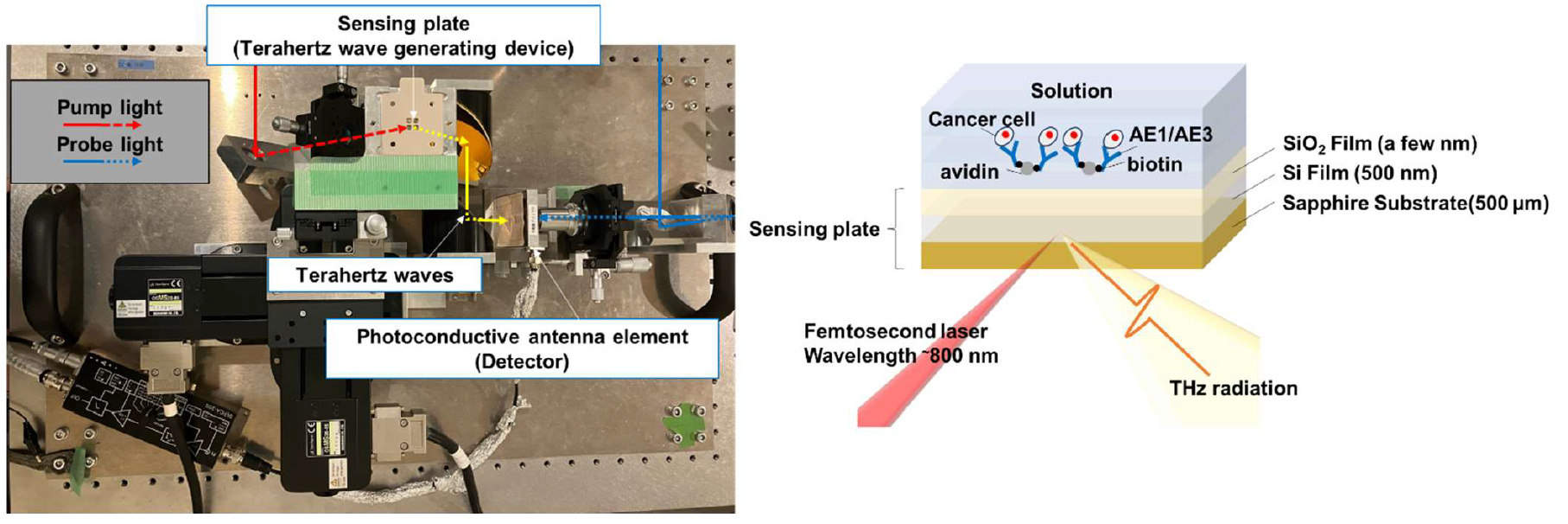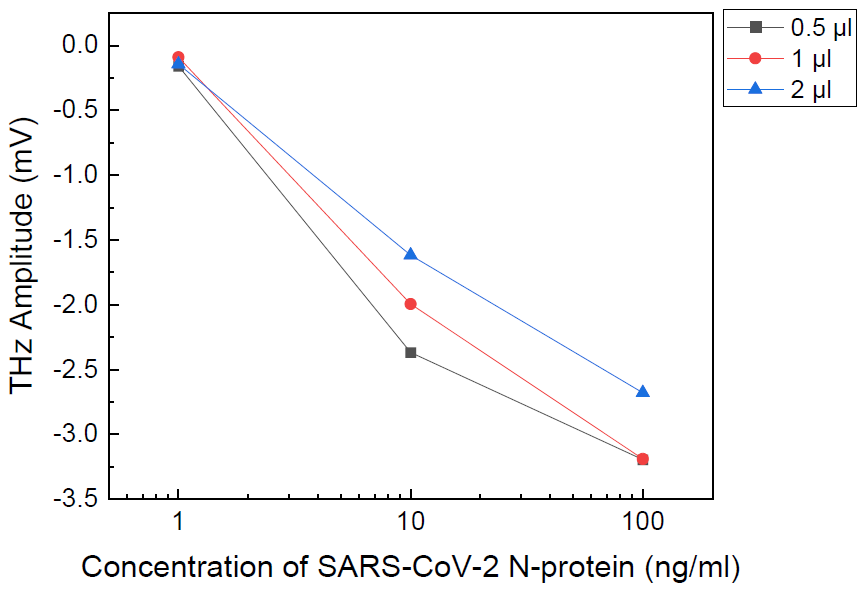| PREVIOUS PRESENTATION | BACK TO PROGRAM OVERVIEW | NEXT PRESENTATION |
Detection of SARS-CoV-2 in A Solution with A Small Volume Using Terahertz Chemical Microscope
Mana Murakami1, Xue Ding1, Sayaka Tsuji1, Jin Wang1, Hirofumi Inoue2, and Toshihiko Kiwa1
1Graduate School of Interdisciplinary Science and Engineering in Health Systems, Okayama University, Okayama, Japan
2Graduate School of Medicine, Dentistry and Pharmaceutical Sciences, Okayama University, Okayama, Japan
Introduction
The novel coronavirus infection (COVID-19), which has been a global pandemic since it was first confirmed in China in December 2019, was moved to Category 5 infectious diseases in May 2023, but it remains a threat to the elderly and people with underlying diseases. New variants of severe acute respiratory syndrome coronavirus 2 (SARS-CoV-2) continue to emerge, and epidemic strains continue to replace them one after another around the world. Currently, polymerase linkage (PCR) tests and antigen tests are mainly used to diagnose SARS-CoV-2. PCR testing is a test method that amplifies and detects RNA gene sequences specific to SARS-CoV-2, and it is highly sensitive and suitable for definitive diagnosis, but its disadvantages include long testing time, the need for specialized equipment and specialized personnel, and high cost. On the other hand, the antigen test is a test method that detects the nucleocapsid protein (N protein) of SARS-CoV-2 and can be tested in about 15~30 minutes, but if the amount of antigen contained in the sample is small, it may be a false negative. That is, it is less sensitive than the
PCR test, so it can be used for screening but not for definitive diagnosis [1]. Therefore, in order to realize a simple and highly sensitive test, we are investigating a method to detect the N protein of SARS-CoV-2 using a terahertz chemical microscope (TCM). When we use TCM, measurement with a small sample volume can be performed in 15 minutes, and quantitative evaluation of terahertz wave intensity is possible. Therefore, it is expected that TCM will be used to establish a new virus testing method that is simpler to pre-treat than PCR testing and more sensitive than antigen testing.
In a previous study, the concentration of N protein was measured, and it was confirmed that the concentration of N protein depends on the intensity of terahertz waves. However, the amount of antigen detected by TCM was higher than the minimum detectable amount of antigen in antigen test kits actually used as a diagnostic tool for COVID-19. Therefore, by utilizing the feature of TCM that it is possible to measure very small amounts and reducing the amount of solution to be measured, it was confirmed that the intensity of the terahertz wave does not depend on the amount of solution, and the usefulness of TCM in the detection of very small amounts of N proteins was demonstrated.
Experiment
Configuration diagram of TCM is showed in Figure 1(a). The laser is divided into probe beam and pump beam by a beam splitter. Pump beam irradiates the sensing plate and is used to generate terahertz wave. And probe beam enters the photoconductive antenna and is used to detect terahertz wave. The THz radiating element used in TCM is called a sensing plate (SP), and TCM is a system that measures the surface potential of the SP as the amplitude of the THz wave emitted from the SP [2-4]. As showed in Figure 1(b), the SP consists of a Si layer and a SiO2 layer formed on a sapphire substrate. When a femtosecond laser is irradiated on the sapphire substrate side of the SP, THz waves are generated inside the Si layer, and THz waves proportional to the depletion layer electric field strength of the Si layer are emitted from the sapphire substrate side. In this study, we demonstrated that a small amount of N protein can be detected by preparing 0.5, 1, and 2 μl sample wells on the SP. First, avidin D (Vector Laboratories, Inc., Newark, CA, USA) was immobilized in the SP. Next, a 50 μg/ml biotinylated anti-SARS-CoV-2 N protein aptamer (purity≥95%, RayBiotech life, inc., Norcross, U.S.A.) immobilized by using the strong binding of avidin and biotin was used. Subsequently, SARS-CoV-2 nucleocapsid protein (N protein) with a C-terminal Histag, derived from transfected human HEK293 cells (purity > 90%, RayBiotech life, inc., Norcross, U.S.A.) was conjugated. The concentration was increased to 1, 10, and 100 ng/ml on the same SP and the reaction was performed for 2.5 hours.

Figure 1: (a) Configuration diagram of TCM. (b) Configuration diagram of the sensing plate.
Result
Figure 1 shows the change in THz wave amplitude intensity before and after the reaction between N protein and aptamer as a function of N protein concentration. The change in THz amplitude intensity decreased as the concentration of N protein increased. In addition, the sensitivity was almost the same regardless of the sample size. In this study, we were able to detect 0.1 pg of N protein by using TCM. According to these results, it is expected to establish a highly sensitive and rapid diagnostic method for COVID-19 using TCM.

Figure 2: THz wave amplitude intensity change as a function of the concentration of N protein at 0.5, 1, and 2 μl of sample
volume, respectively.
References
[1] V. T. Chu et al., “Comparison of Home Antigen Testing With RT-PCR and Viral Culture During the Course of SARS-CoV-2 Infection,” JAMA Intern Med. 182(7) 701–709 (2022)
[2] T. Kiwa, J. Kondo, S. Oka, I. Kawayama, H. Yamada, M. Tonouchi, and K. Tsukada, “Chemical sensing plate with a laser-terahertz monitoring system,” Applied Optics 47(18) 3324-3327 (2008)
[3] T. Kiwa, Y. Kondo, Y. Minami, I. Kawayama, M. Tonouchi, K. Tsukada, “Terahertz chemical microscope for label-free detection of protein complex,” Applied Physics Letters 96(21), 211114 (2010)
[4] T. Kiwa, T. Kamiya, T. Morimoto, K. Sakai, K. Tsukada, “pH measurements in 16-nL-volume solutions using terahertz chemical microscopy,” Optics Express 26(7), 8232-8238 (2018)
